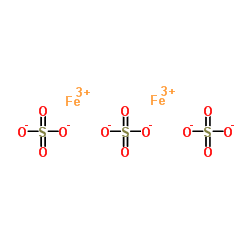10028-22-5
| Name | iron(3+) sulfate |
|---|---|
| Synonyms |
Ferric Sulphate
DIIRON TRISULFATE Iron(III) sulfate hydrate Iron(III) sulphate iron (III) sulfate MFCD00011007 Iron(3+) sulfate (2:3) Ferric sulfate Diiron tris(sulphate) iron(3+),trisulfate diferric trisulfate UNII:4YKQ1X5E5Y EINECS 233-072-9 Ferric sulfate |
| Density | 3.097 |
|---|---|
| Boiling Point | 330ºC at 760 mmHg |
| Melting Point | 480°C |
| Molecular Formula | Fe2O12S3 |
| Molecular Weight | 399.878 |
| Exact Mass | 399.725067 |
| PSA | 265.92000 |
Synonym:Diiron Trisulfate; Ferric Sulfate; Iron Persulfate; Iron Sesquisulfate; Iron Sulfate (2:3); Iron (3+) Sulfate; Sulfuric Acid, Iro Section 2 - COMPOSITION, INFORMATION ON INGREDIENTS
Risk Phrases: 22 Section 3 - HAZARDS IDENTIFICATION EMERGENCY OVERVIEW
Harmful if swallowed. Potential Health Effects Eye: May cause eye irritation. Skin: May cause skin irritation. Ingestion: May cause severe gastrointestinal tract irritation with nausea, vomiting and possible burns. May cause liver and kidney damage. Inhalation: May cause respiratory tract irritation. Chronic: No information found. Section 4 - FIRST AID MEASURES Eyes: Flush eyes with plenty of water for at least 15 minutes, occasionally lifting the upper and lower eyelids. Get medical aid immediately. Skin: Get medical aid if irritation develops or persists. Flush skin with plenty of soap and water. Ingestion: If victim is conscious and alert, give 2-4 cupfuls of milk or water. Never give anything by mouth to an unconscious person. Get medical aid immediately. Inhalation: Get medical aid immediately. Remove from exposure and move to fresh air immediately. If not breathing, give artificial respiration. If breathing is difficult, give oxygen. Notes to Physician: Section 5 - FIRE FIGHTING MEASURES General Information: As in any fire, wear a self-contained breathing apparatus in pressure-demand, MSHA/NIOSH (approved or equivalent), and full protective gear. Extinguishing Media: Use alcohol foam, carbon dioxide, or water spray when fighting fires involving this material. Section 6 - ACCIDENTAL RELEASE MEASURES General Information: Use proper personal protective equipment as indicated in Section 8. Spills/Leaks: Clean up spills immediately, observing precautions in the Protective Equipment section. Sweep up or absorb material, then place into a suitable clean, dry, closed container for disposal. Section 7 - HANDLING and STORAGE Handling: Wash thoroughly after handling. Remove contaminated clothing and wash before reuse. Use with adequate ventilation. Discard contaminated shoes. Storage: Store in a cool, dry place. Keep containers tightly closed. Section 8 - EXPOSURE CONTROLS, PERSONAL PROTECTION Engineering Controls: Use adequate ventilation to keep airborne concentrations low. Exposure Limits CAS# 10028-22-5: Belgium - TWA: (listed as iron salts (soluble)): 1 mg/m3 VLE (as Malaysia: (listed as iron salts (soluble)): 1 mg/m3 TWA (as Fe) Netherlands: (listed as iron salts (soluble)): 1 mg/m3 MAC (as Fe Spain: (listed as iron salts (soluble)): 1 mg/m3 VLA-ED (as Fe) Personal Protective Equipment Eyes: Wear appropriate protective eyeglasses or chemical safety goggles as described by OSHA's eye and face protection regulations in 29 CFR 1910.133 or European Standard EN166. Skin: Wear appropriate protective gloves to prevent skin exposure. Clothing: Wear appropriate protective clothing to prevent skin exposure. Respirators: A respiratory protection program that meets OSHA's 29 CFR 1910.134 and ANSI Z88.2 requirements or European Standard EN 149 must be followed whenever workplace conditions warrant respirator use. Section 9 - PHYSICAL AND CHEMICAL PROPERTIES Physical State: Solid Color: yellow-gray Odor: odorless pH: Not available. Vapor Pressure: Negligible. Viscosity: Not available. Boiling Point: Not applicable. Freezing/Melting Point: Decomposes. Autoignition Temperature: Not applicable. Flash Point: Not applicable. Explosion Limits, lower: Not available. Explosion Limits, upper: Not available. Decomposition Temperature: 480 deg C Solubility in water: Soluble in water. Specific Gravity/Density: 3.097 Molecular Formula: Fe2(SO4)3.H2O Molecular Weight: 399.8668 Section 10 - STABILITY AND REACTIVITY Chemical Stability: Stable under normal temperatures and pressures. Conditions to Avoid: Incompatible materials. Incompatibilities with Other Materials: Corrosive to metals. Hazardous Decomposition Products: Sulfur oxides (SOx), including sulfur oxide and sulfur dioxide. Hazardous Polymerization: Will not occur. Section 11 - TOXICOLOGICAL INFORMATION RTECS#: CAS# 10028-22-5: NO8505000 LD50/LC50: Not available. Carcinogenicity: Ferric sulfate, monohydrate - Not listed by ACGIH, IARC, or NTP. Other: See actual entry in RTECS for complete information. Section 12 - ECOLOGICAL INFORMATION Section 13 - DISPOSAL CONSIDERATIONS Products which are considered hazardous for supply are classified as Special Waste and the disposal of such chemicals is covered by regulations which may vary according to location. Contact a specialist disposal company or the local waste regulator for advice. Empty containers must be decontaminated before returning for recycling. Section 14 - TRANSPORT INFORMATION IATA Not regulated as a hazardous material. IMO Not regulated as a hazardous material. RID/ADR Not regulated as a hazardous material. USA RQ: CAS# 10028-22-5: 1000 lb final RQ; 454 kg final RQ Section 15 - REGULATORY INFORMATION European/International Regulations European Labeling in Accordance with EC Directives Hazard Symbols: XN Risk Phrases: R 22 Harmful if swallowed. Safety Phrases: S 26 In case of contact with eyes, rinse immediately with plenty of water and seek medical advice. WGK (Water Danger/Protection) CAS# 10028-22-5: 1 Canada CAS# 10028-22-5 is listed on Canada's DSL List. CAS# 10028-22-5 is not listed on Canada's Ingredient Disclosure List. US FEDERAL TSCA CAS# 10028-22-5 is listed on the TSCA inventory. SECTION 16 - ADDITIONAL INFORMATION N/A |
CHEMICAL IDENTIFICATION
HEALTH HAZARD DATAACUTE TOXICITY DATA
MUTATION DATA
|
| Hazard Codes | Xn:Harmful |
|---|---|
| Risk Phrases | R22;R36/37 |
| Safety Phrases | S26 |
| RIDADR | UN 9121 |
| WGK Germany | 3 |
| RTECS | NO8520000 |

